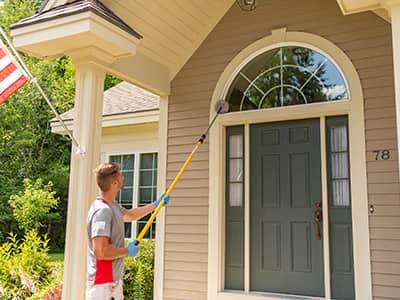What do carpenter bees look like?
Eastern carpenter bees are about ¼ to 1-inch long. They have sleek, black bodies and a patch of yellow fuzzy hair on their thoraxes. Female carpenter bees have stingers, male carpenter bees do not.

How do you tell the difference between carpenter bees and bumble bees?
Carpenter bees are often mistaken for bumble bees and with good reason, they are very similar in size and appearance. The easiest way to tell them apart is to take note of the hair. Whereas carpenter bees only have the patch of yellow hair on their thoraxes, the abdomens of bumble bees are quite fuzzy. Another way to determine if the pest is a carpenter bee or bumble bee is to take note of how many you see and where. Typically, carpenter bees are solitary insects that do not live in nests or colonies. Bumble bees, on the other hand, are social insects that live in colonies.
What do carpenter bees eat?
Although carpenter bees “drill” holes into wood, they do not eat wood. Instead, they feed on flower nectar and pollen.
Do carpenter bees sting?
Female carpenter bees may sting but only if provoked. Male carpenter bees do not sting but are very territorial and will hover close around people and animals that get too close.
Are carpenter bees dangerous?
Because female carpenter bees are capable of stinging and their venom is strong enough to cause allergic reactions, these stinging pests should be considered dangerous. Of course, not everyone who is stung by a carpenter bee will experience this kind of reaction. If stung by bees, wasps, or other stinging insects and you show signs of an allergic reaction, seek medical attention right away.
What are the signs of carpenter bees?
If you’re concerned that you might have a carpenter bee problem on your property, look for these telltale signs of carpenter bee activity:
- Circular entrance holes in wood
- Sawdust on the ground below entrance holes
- Yellowing near entrance holes which is a combination of pollen and feces
- Male carpenter bees protecting their territory
- The presence of woodpeckers
How do I get rid of carpenter bees?
To resolve an existing carpenter bee problem, please reach out to Pine State Pest Solutions. Offering carpenter bee solutions in several Maine counties including Kennebec, Androscoggin, Sagadahoc, Oxford, Cumberland, and York, our locally owned and operated pest control company is well-versed in getting rid of carpenter bees and other stinging insects. Reach out today with questions or to schedule service!
Protect your home from carpenter bees & other pests
Home Protection Plan
Starting as low as $35/month*

Pine State’s Home Protection is an affordable pest control plan that is ideal for homeowners who want general pest control services that target common house-infesting insects and rodents.
When you sign up for this ongoing service, you’ll receive an initial service visit to treat the existing pest problem and then seasonal service visits spread out over the year to ensure pests stay out. That’s a total of four services annually.
Pests covered under Pine State’s Home Protection plan include carpenter ants, cornfield ants, crazy ants, field ants, little black ants, pavement ants, Asian lady beetles, carpet beetles, cigarette beetles, drugstore beetles, flour beetles, ground beetles, hide beetles, larder beetles, saw-toothed grain beetles, warehouse beetles, boxelder bugs, carpenter bees, centipedes, clover mites, American cockroaches, brown-banded cockroaches, wood cockroaches, field crickets, house crickets, European earwigs, firebrats, bald-faced hornets, European hornets, deer mice, house mice, millipedes, Angoumois grain moths, drain moths, Indian meal moths, Mediterranean flour moths, mud daubers, Norway rats, paper wasps, pill bugs, rice weevils, silverfish, sow bugs, springtails, cellar spiders, daddy longlegs spiders, house spiders, jumping spiders, sac spiders, wolf spiders, Western conifer seed bugs, and yellow jackets.
*Some exclusions apply- please see your agreement
How do I prevent carpenter bee activity
The best way to prevent carpenter bees from drilling holes into your home or on your property is to make it less attractive to them. To accomplish that task, our exterminators recommend the following carpenter bee prevention tips:
- Coat wood surfaces with paint, stain, or varnish
- Seal existing carpenter bee holes or cracks
- Do not plant flowering plants and landscaping too close to your home
- Consider using hardwoods rather than softwoods that carpenter bees prefer
